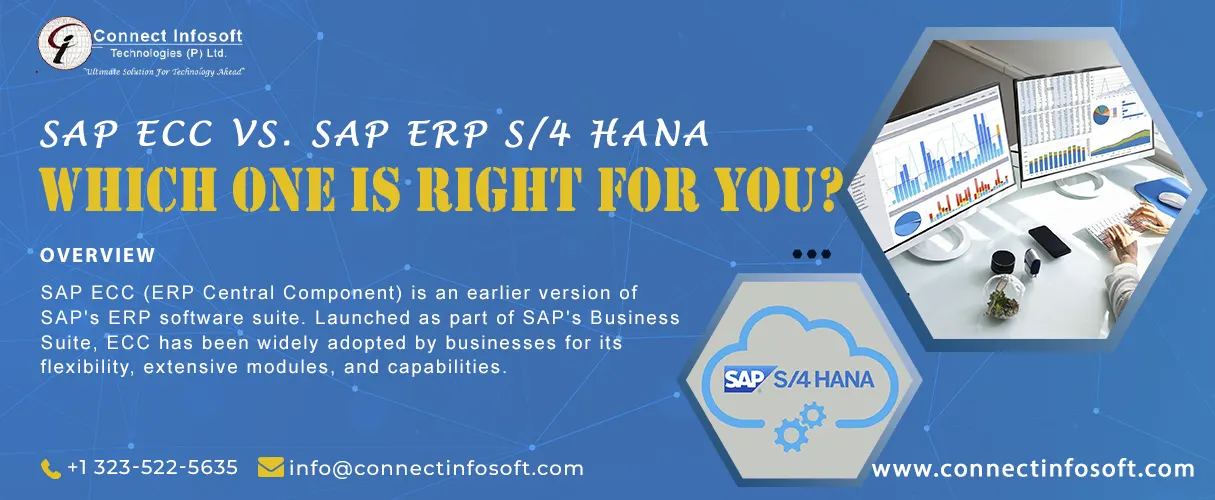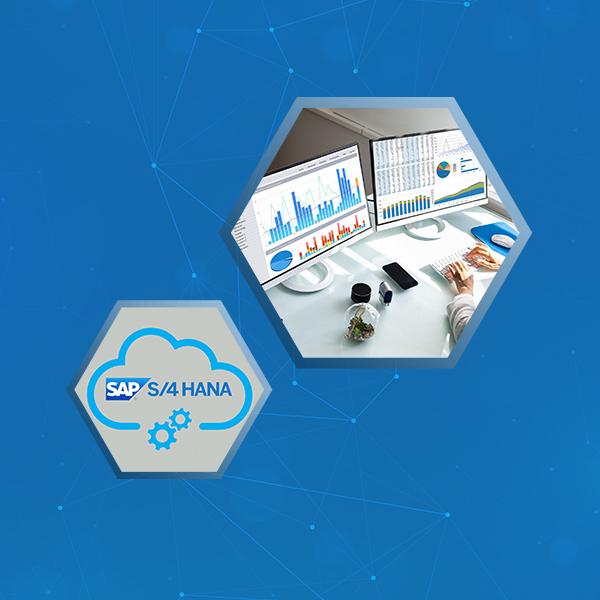SAP ECC vs. SAP ERP S/4 HANA: Which One Is Right for You?

For many years, SAP has been the trusted leader in this fast-changing world of enterprise resource planning (ERP). Now that businesses are trying to find ways to make operations easier and more efficient while also improving performance, the decision to choose between SAP ECC and SAP ERP S/4 HANA has become critical. Both have powerful functionalities but differ drastically when it comes to technology, architecture, and capabilities.
This guide will help you understand the key differences and assess which solution is right for your business.
Overview of SAP ECC and SAP ERP S/4 HANA
SAP ECC
SAP ECC is the earlier version of SAP's ERP suite of software. Released within the suite of SAP Business Suite, ECC has been widely adopted into businesses due to its flexibility and extensive modules and functionalities. ECC is built with a traditional relational database as it provides stability and comprehensiveness through core functionalities that go about finance, human resources, logistics, and much more.
SAP ERP S/4 HANA
It was the next ERP solution released in 2015 by SAP. In S/4 HANA, innovation is the move to exploit the in-memory database SAP HANA means that a business solution offers an even more simplified, and analytical immediately reactive data model. Focused on innovations here are all about a streamlined, intuitive user experience: to help support digital transformation or businesses' success in a continuously rising data-driven world.
Differences Between SAP ECC, and SAP ERP S /4 HANA
A. Database Structure and Performance
- SAP ECC: Use legacy databases such as Oracle, IBM DB2, or Microsoft SQL Server. For each business process, separate tables are used for storing data, which can have an impact on performance and sometimes create data redundancy.
- SAP S/4 HANA: It is purely based on the SAP HANA in-memory database, where the processing of information takes place in real-time with minimal redundancy in data. The one-table design in S/4 HANA for business transactions also reduces the data footprint, thus making it easier to handle. This means the data would become reportable in less time and would yield quick analytics.
B. User Interface and Usability
- SAP ECC: Makes use of SAP GUI (Graphical User Interface), which although has done its work for all those years is relatively out-of-date and less user-friendly.
- SAP S/4 HANA: The SAP Fiori is of modern UX, more user-friendly, responsive, and accessible on devices. The role-based apps through Fiori are customized around users' needs and result in improved productivity as well as the overall user experience.
C. Data Processing and Analytics
- SAP ECC: The process mostly depends on batch processing which causes delays in analytics that would otherwise be available and thus affects the time scale for making business decisions based on data analysis.
- SAP S/4 HANA: It is designed with direct support of advanced analytics and real-time processing capabilities for the transactional data. With its in-memory data processing capabilities, quicker insights are facilitated, and quicker decisions will support real-time business operations.
D. Business Process Innovation
- SAP ECC: ECC has traditional setups and lacks the most advanced capabilities and innovations from what is available in S/4 HANA.
- SAP S/4 HANA: Streamlines and rethinks most of the business processes. Brings more features in areas of finance, supply chain, and manufacturing. Supports newer technologies like machine learning and AI. Businesses can utilize intelligent automation to drive process improvements.
E. Customization and Flexibility
- SAP ECC: Allows extreme customization. The company is then allowed to tailor business processes towards a specific business need. But this makes the upgrade very tedious and time-consuming.
- SAP S/4 HANA: It decreases the number of customizations because there is more out-of-the-box solution, hence it would be easier for an organization to upgrade and allow rapid implementation. The S/4 HANA simple data model supports adaption and scale to all the changing requirements of a business.
Advantages of SAP ECC and SAP S/4 HANA
Advantages of SAP ECC
1. Proven Stability: For decades, ECC has been used in worldwide companies; it is reliable and stable.
2. Customizability: The modular structure allows for specific business needs customizing on ECC.
3. Extensive Partner Support: There are thousands of consulting partners who are ECC-experienced, and hence, it is easy to find support.
Advantages of SAP S/4 HANA
1. Real-Time Analytics: The in-memory capabilities of S/4 HANA enable real-time analytics, which provide instant insights.
2. Enhanced User Experience: Fiori UX provides an intuitive and streamlined interface for the users.
3. Future-Proofing: S/4 HANA is integrated with advanced technologies such as AI, machine learning, and IoT, preparing businesses for the future of ERP.
Migration Considerations. Migration from SAP ECC into SAP S/4HANA
The migration would have its complexity and value; however, it is useful for businesses already using SAP ECC.
Some of these considerations are:
A. Technical Readiness
These involve technical upgrades but in terms of database hardware requirements. Infrastructure and relevant support are a must requirement to ensure that the overall transition is smooth.
B. Simplification of data Models
S/4 HANA's simplified data structure could demand data cleansing and reorganization. Companies need to go through the data in terms of quality and execute all the necessary adjustments to fit the new model.
C. Code Customization
Some customizations in ECC will not be directly portable and need to be adjusted or rewritten. SAP has pre-empted these issues and initiated the availability of certain tools like Readiness Check for identifying the compatibility of codes.
D. Process Rationalization
This shift into S/4 HANA can afford the revisiting of the process to polish. This, instead of following an antiquated practice of duplicating past practices, seizes the chance afforded in the implementation of S/4 HANA by making it much more efficient along with far fewer overhead costs.
Which one shall You Implement For Your Business
Use SAP ECC if:
Choose SAP ECC if:
1. You prioritize stability and need a mature, proven system with wide support across industries.
2. Your business doesn’t require real-time processing, and batch processing capabilities are sufficient.
3. You have significant customizations and aren’t ready to adjust them or undergo a complex migration.
Choose SAP S/4 HANA if:
1. You seek real-time processing and require immediate insights and decision-making capabilities.
2. User experience is critical to your operations, and you need an intuitive, mobile-friendly interface.
3. Your business is undergoing digital transformation and you want to leverage advanced technologies like AI, IoT, and machine learning.
4. Future-proofing is a priority, and you want to ensure your ERP system can evolve with technological advances and changing market demands.
Conclusion
SAP ECC and SAP ERP S/4 HANA are strong solutions for enterprise resource planning but business needs and priorities will differ. SAP ECC will be useful if organizations need a stable, customized ERP system with broad functionalities, while SAP S/4 HANA is ideal for innovation and process streamlining and real-time insights toward a digital-first future.
Assess your business's needs and growth plans as well as how technically ready it is. If running SAP ECC, consider SAP S/4 HANA and weigh out the potential benefits over the cost and complexity to your business. Taking either road would lead your business to greater operational efficiency and proper success within a very competitive landscape.


